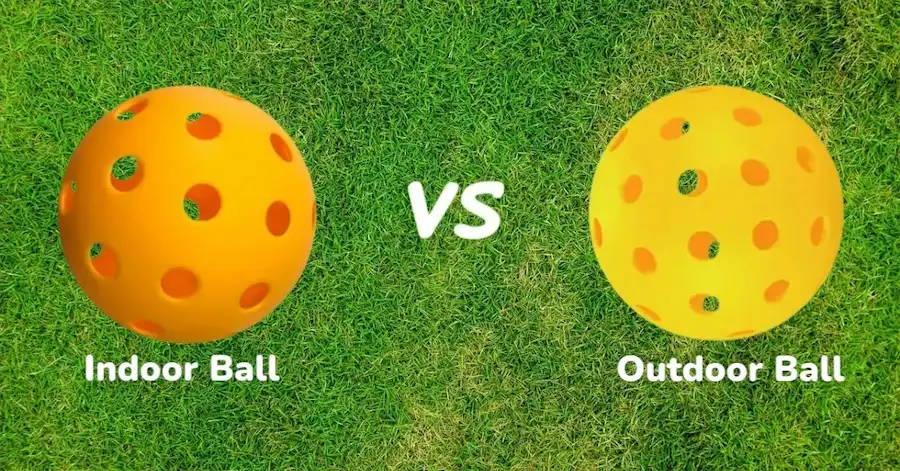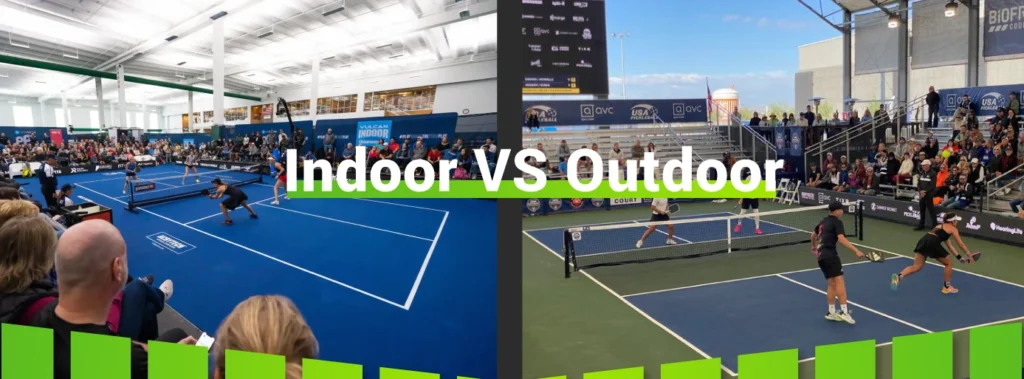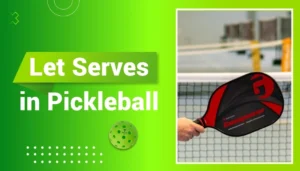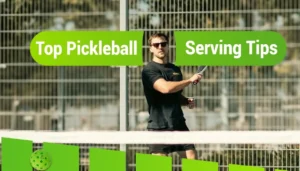The first time I took my indoor game outdoors, I got wrecked. My shots drifted in the wind, the sun blinded me mid-serve, and the ball? Totally different bounce and feel. I thought, “How hard could it be?” Spoiler alert: very.
That’s when I realized indoor and outdoor pickleball are two different beasts. Since then, I’ve learned how to adjust my game for each. So whether you’re playing under the lights or the sunshine, here’s what I’ve figured out—so you can thrive in both worlds.
Indoor vs Outdoor Pickleball: Quick Comparison Table
| Feature | Indoor Pickleball | Outdoor Pickleball |
|---|---|---|
| Court Surface | Hardwood or sport court (smooth, slick) | Asphalt, concrete, or tennis courts (gritty) |
| Ball Type | Lighter, larger holes (26), softer plastic | Heavier, smaller holes (40), harder plastic |
| Ball Bounce | Lower, faster bounce | Higher, slightly slower bounce |
| Pace of Game | Fast, quick reactions needed | Slower, more strategic |
| Weather Factors | None – controlled environment | Wind, sun, and surface imperfections matter |
| Strategy Focus | Quick volleys, dinks, net play | Power shots, topspin, deeper play |
| Footwear Needs | Shoes with grip for slick floors | Cushioned shoes for impact on hard surfaces |
| Body Impact | Easier on joints (some court “give”) | Tougher on joints (hard surfaces) |
| Social Feel | League play, structured, climate-proof | Laid-back, spontaneous, fresh air vibes |
| Best For | Precision training, consistency | Challenge, adaptability, outdoor fun |
Court Surfaces: The Foundation of Your Game

Indoor Court Surfaces
When I’m playing indoors, I love the feel of the smooth, fast hardwood under my shoes. It’s usually on a basketball court or a sport-specific gym floor, and it’s slick enough to keep the pace lightning-quick.
But here’s the catch: the ball doesn’t bounce very high. Early on, I was caught flat-footed more times than I can count. If you’re not familiar with how indoor courts are laid out or what kind of space you need, it’s worth checking out this helpful guide on indoor court setup and layout to get the full picture before stepping on the court.
My Trick: I’ve learned to stay on the balls of my feet, paddle ready, because if I’m not reacting fast, I’m losing the point. Also—grippy shoes are everything. I upgraded to a pair with excellent traction after nearly slipping on a sharp lateral move. Total game-changer.
Outdoor Court Surfaces

Outdoor courts? They’ve got personality. I’ve played on everything from gritty asphalt to tennis court surfaces with weird cracks and slightly slanted edges.
They tend to give a higher bounce and a slower pace overall, but they also demand more physicality—and attention.
My Advice: Watch for those tiny cracks and dips. Once, my opponent hit a simple drop shot that landed right on a raised spot—and the ball shot sideways.
Nothing prepares you for that kind of chaos. I also rely on shoes with more cushion outdoors to protect my knees on the harder surface.
Ball Differences: The Tools of the Trade

Indoor Pickleballs
Indoor balls are my go-to when I want a longer rally and finesse play. They’re made of softer plastic with bigger holes, which makes them easier to control and great for soft hands at the kitchen line. I love using them to practice dinks, drop shots, and controlled volleys.
My Tip: Indoor play is where I really sharpen my touch. I slow things down, keep the ball in play, and work on patience—which, let’s be honest, doesn’t always come easy for me during a competitive match!
Outdoor Pickleballs
Oh, outdoor balls… they’re tough. Heavier, harder, smaller holes—designed to handle the elements. But wow, they take some getting used to.
I remember switching to an outdoor ball and feeling like my paddle had suddenly lost its magic. It took more muscle and precision to get the same result.
My Strategy: I hit harder, drive more, and go for depth. Outdoor balls don’t give you much grace—you’ve gotta bring the heat and hit through them. I even had to adjust my grip and swing mechanics to get used to the extra weight and speed.
The Weather Factor: Friend or Foe?
I’ve played in all kinds of conditions—windy days where I had to chase the ball halfway across the court, sunny afternoons that left me squinting through every serve. One memorable match was basically a battle against a 15-mph crosswind. The ball curved like a boomerang!
My Wind Game: I keep shots low, add topspin when I can, and avoid floaty lobs (unless I want to watch them fly into a different zip code). And yes—I’ve learned to serve with the wind when possible.
My Sun Hack: A solid cap and polarized sunglasses save my game—and my sanity.
Indoor Advantages
Indoors? Oh, it’s paradise. No wind, no sun, no uneven bounce. It’s like the court and I have a silent agreement: we’re here to play fair. That makes indoor time perfect for dialing in my technique and executing consistent drills.
If you’re new to the game, starting indoors can make learning a whole lot easier.
I use indoor games to experiment—changing paddle angles, trying new footwork patterns, and refining my drops and resets.
Strategy Shifts: Adapting Your Game to Each Environment
When I’m inside, I stay close to the net, play aggressive, and rely on quick hands. The fast surface rewards players who can control the tempo—and punish loose shots. My indoor mindset is all about short, sharp, and smart.
Pro Move: If someone sends me a soft shot, I attack it with a sharp volley. No hesitation.
Outdoor Strategies
Outdoors, I pace myself more. The game flows slower, so I use that time to set up smarter plays. My third-shot drops become even more important, and I’ll mix in lobs and deep serves to test my opponent’s footwork.
Wind? That’s just part of the puzzle. I embrace it now—sometimes using it to curve my serve or push opponents off their rhythm.
Social & Environmental Aspects
Indoor play is all about comfort. No surprises, no sudden weather shifts, just good ol’ pickleball. Indoor courts are also great for meeting other players and joining leagues since everything is more consistent.
Pro Tip: Indoor play is perfect for improving your technique. Take advantage of the controlled environment to focus on precision shots and leveling up your game.
Outdoor Play: Fresh Air and Freedom
On the flip side, there’s something magical about outdoor pickleball. The fresh air, the wide-open spaces, the unpredictability of nature—it all adds to the excitement. Plus, outdoor games tend to feel more casual, giving you a chance to relax and enjoy the moment with friends.
Pro Tip: Make outdoor play a social event! Pick a time when the weather is nice, bring your friends, and enjoy some laid-back games with a side of sunshine.
So…Which Court Wins?
After everything I’ve learned, the truth is this:
Neither indoor nor outdoor pickleball is “better”—they’re just different beasts.
Indoors, I’m sharper, quicker, more technical. Outdoors, I’m strategic, resilient, and open to whatever nature throws my way. And honestly, I wouldn’t trade one for the other. They’ve both made me a better, more well-rounded player.
So if you’re wondering where to play—play everywhere. Play in gyms, parks, community centers, driveways. Grab your paddle, adjust your game, and keep having fun.
Because at the end of the day, it’s not about the wind or the walls—it’s about the love of the game.
Indoor vs Outdoor Pickleball: FAQs
1. What’s the biggest difference between indoor vs outdoor pickleball?
The main difference is the court surface and how the ball behaves. Indoor pickleballs are lighter with larger holes, making them easier to control, while outdoor balls are heavier and designed to handle wind and rougher surfaces.
2. Can I use the same ball for both indoor and outdoor play?
Technically, you can, but it’s not recommended. Indoor balls are lighter and softer, which can make them tricky to control outdoors, especially in the wind. Outdoor balls are heavier and work better on rough surfaces.
3. Which surface is harder on my body—indoor or outdoor courts?
Outdoor courts (like concrete and asphalt) are tougher on your joints, while indoor courts (like sport or basketball floors) usually have more give, making them easier on your knees and ankles.
4. Is indoor pickleball faster than outdoor pickleball?
Yes! Indoor games tend to be faster because of the smoother court surface and lower ball bounce, while outdoor games often feel slower due to the wind and ball’s higher bounce on rougher surfaces.
5. How do I adjust for wind when playing outdoor pickleball?
To handle the wind, keep your shots low and use topspin to help control the ball. You’ll also want to avoid risky, high lobs if it’s particularly gusty.
6. What are the advantages of playing pickleball indoors?
Indoor pickleball offers consistent conditions—no wind, sun, or weather issues to worry about. It’s also great for focusing on technique and keeping games steady and controlled.
7. Can I play outdoor pickleball in any weather?
Outdoor pickleball is fun in most conditions, but strong winds, rain, or extreme temperatures can make it challenging. Be prepared for anything and adjust your game accordingly!
8. Does the ball bounce differently indoors versus outdoors?
Absolutely. Indoor courts give you a lower bounce because of the smoother surface, while outdoor courts usually provide a higher bounce, especially on rougher surfaces like asphalt.
9. Which type of pickleball is better for beginners—indoor or outdoor?
Indoor pickleball is often easier for beginners since there are fewer variables (like wind or sun), and the ball is easier to control, making it great for learning the basics.
10. How should I choose where to play—indoors or outdoors?
It depends on what you prefer! If you like consistent gameplay and comfort, try indoors. If you enjoy a challenge and fresh air, outdoor pickleball might be more fun.


